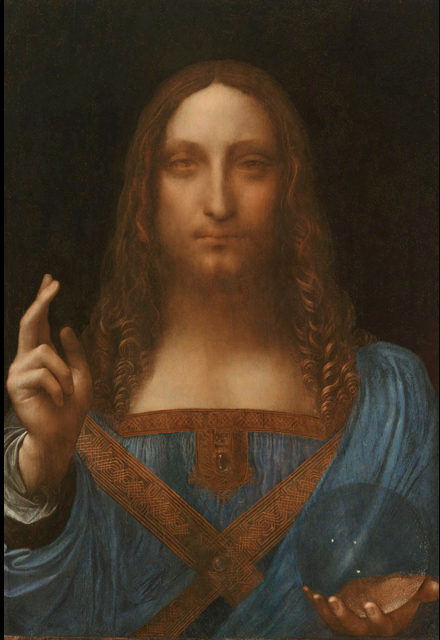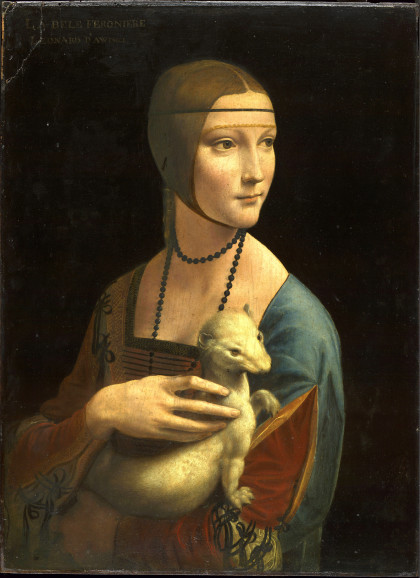
Next month, the National Gallery of London will display a “previously-unknown work by Leonardo da Vinci.” Called Salvator Mundi (i.e. “Savior of the World”), the painting has been compared to surviving, fragmented preparatory drawings and undisputed paintings by da Vinci. As a result, many scholars believe it should be counted among a handful of paintings by the artist. Others doubt. The portrait of Christ will be on display in the exhibition Leonardo da Vinci: Painter at the Court of Milan, opening on November 9 in London, for everyone to compare and opine.
Anticipating certain and divisive scrutiny, Nicholas Penny, the Director of the National Gallery, says he is “pretty sure” it is by da Vinci. He was interviewed by The Sunday Times(London) for a feature in the paper’s magazine titled “Leonardo? Convince Me.”:
“It is a very weird picture.” . . . It shares something, he says, with Leonardo’s portraits The Lady with the Ermine and the Mona Lisa. “They respond, but hold something back. You can’t think about them except in relationship to the viewer. They imply a narrative of which you are a part. That was not true of portraiture before Leonardo. The Salvator Mundi radiates intense presence. But because it’s Leonardo you do wonder if you’re going mad–and you certainly want people whose opinions you respect to look at it.” He pauses. “People can judge for themselves.” (Sunday Times Magazine. 9 OCT 2011.)
Before becoming Director, Mr. Penny was the Clore Curator of Renaissance Art at the National Gallery for ten years. He is a serious scholar; an expert. But, his advice here is nonsense. We may never be able to decisively attribute the painting to da Vinci–it has been over 500 years. But, we can certainly do better than stand in front of it to experience “radiated presence”–whatever that means–or take comfort in an “implied narrative.” It is the kind of non-methodical, relativistic drivel that has made art history and art historians completely irrelevant to public debate in our evidence-based era.
I don’t think Mr. Penny’s advice in this interview is the basis for his opinions; but, he has been trained by a hundred years of art historical practice to talk to the public about art in an imprecise and unhelpful way. The Salvator Mundi painting has been through a host of scientific tests, including carbon dating and comparative chemical testing of pigments used in undisputed da Vinci paintings; and, a series of comparative stylistic studies, such as analysis of stroke and process. These are not the kind of tools available to average museum-goers who Mr. Penny invites to “judge for themselves.” If he were a lawyer, we would expect him to say “Here is the compelling evidence for and against . . . therefore I am pretty sure it is attributable to da Vinci.” not: “I’m pretty sure . . . It’s weird . . . ask someone else.” It is a sign of our times that a trained scholar and Director of one of the world’s great museums would tell people to look at and interpret a Renaissance painting as though it were a 1960s drip painting. It is evidence of the public death of a way of talking about art called the “Morellian Method.”

Giovanni Morelli (1816-1891) was a trained doctor who had a love of art. During his lifetime, royal and national museums sprung up throughout Europe. Many Old-Master works were placed on public display for the first time, leading to an international public dialogue on art not seen before or since. Competing for attention, these collections–sometimes of dubious origins– were often overzealous and sloppy in attributing works of art to marquee names. Paintings labelled “da Vinci” have since been downgraded to “School of da Vinci” or “Unknown Florentine Artist.” At the time, art historians, critics and collectors were anxious to divide up painters into similar Schools (e.g. Spanish, French, Neopolitan) by observations of subject, palette and, even, size. Morelli had a different approach. He suggested that the same rigorous scientific methods used in medicine (e.g. dissection and observation) be applied to the observation of paintings. In particular, Morelli believed that an artist was best known by the minute and inconsequential parts of a painting: leaves on trees, fingernails, dirt. Artists didn’t reveal themselves in the big things; but, in the mundane areas of their art that were not subject to constant reinvention. He wrote detailed treatises on the varied hand gestures of particular painters, contrasting them with others. Over time, he was considered a kind of Sherlock Holmes of painting.Though some of his attributions were incorrect, Morelli’s object-based method pre-dated many scientific tools that his nineteenth-century philosophy would have embraced.

By the early twentieth century, paintings were interpreted differently. Art was considered mostly through philosophical arguments alone, not craftsmanship combined with philosophy. Morelli was not relevant to Dadaists or Pop Artists. But, it was my belief that thos, like Mr. Penny, who continued to study art in the Classical Tradition, would retain the rigor and language of a scientific method in order to understand, preserve and teach the public about these works. I think Mr. Penny has a deep understanding–many years beyond technical possibilities of Morelli’s era–but his comments appear to indicate his lack of belief public capacity or interest to see paintings in a rigorous way. Maybe that is just my implied narrative.
“They imply a narrative of which you are a part”
I wonder if this hints at the real agenda: create pop culture buzz (what better way than to tell everyone they are a part of it) hoping to parlay it into a financial payoff, and matters of scholarship be damned?
I’d be interested to hear the scientific evidence mentioned, but can’t believe that the painting is by da Vinci. Would the master of composition create a flat, cramped design, with a disconnected body, and questionable fore-shortening?
I don’t know the evidence against the “Bacchus”, but at least it’s a good painting.
What do you think by the way?
Roman, I agree with your larger point. I don’t believe in this painting as a Leonardo, though. The very unbeautiful right hand kills it for me. The almost Modigliani-like squint in the eyes, as well, which are placed fractionally too high in the skull. I actually don’t care what any authority says. If Leonardo did paint this, he should have mirror-written an apology on the back.
It’s good to hear from you. I have not seen this Leonardo in person. But, I have seen several others. It is difficult to know how much of what we see is original to Leonardo and how much of it has been adjusted or lost by time. Artists from that period could be astonishingly experimental and varied in their productions. The difference between two Raphael’s a decade apart is dramatic and, were it not for rock-solid attributions–lead to the conclusion that they were done by entirely different artists. So, while I agree with you that some parts seem out of sync, it’s hard for me to feel comfortable without a full evidentiary body of proof. And, even then, there are questions.
It’s nice to be back! What would be fully convincing to you, Roman? I know what you mean about Raphael — in a short life that hardly skirted middle age, then years make a big gap. Unless this work is so over-painted that we can just never know who did what, when you see some quirks that were not Leonardo’s quirks, what can one say? I know the faces of some very famous Titian nudes were over-painted, but that area is only 2 % of the total composition, and there’s so much else to look at. Here, what — apart from a Leonardesque vibe — is there to say it was painted by Leonardo? I am no expert, just an art lover, so I am sure I am short on methodology. Let’s pretend you had a Salvator Mundi that bid fair to be by Giotto. Someone could have effaced the planful, intent look of deep understanding one often sees on Giotto’s faces, but the slight arch of the wrist might still be there. How does anyone ever decide, in the absence of unusually complete histories for these works?
well abstract impressionism and alot of isms are nice actually the mmain
main reason why alot of people don’t understand Renascence and alot of the old art is because they dont know ,the ,stories ,the people,stories
while resulting to no appreciation except for the how it looks good factor but we cant easily say that 20th century artist have had bad education in art because we live in the modern days everything every information is almost shared and we know more than what we knew before while i would like to lie and say something plastic about the topic i really think your messed up really your down grading a lot of artist because you don’t like their art
and yes its our lives hello
we don’t care about being good in making realistic stuff all we want is to express create art yeah ive been ,studying solomon j solomon ,bridgeman ,monet ,and alot of those classical stuff and things and ,and all those famouse shit but the more i make something for accuracy and educational sake the more i want to give up on being an artist cuz god its boring all about education this and that
and the reason why i was soo afraid to not know or to be bad is because i was taken by the fear i was afraid something horrible would happen to me if i didn’t know all the anatomy the colors the perspective composition lines shadow
and avoided creating art because i didn’t want to fail i didnt want to be a loser
and the more i did that the more i lost the meaning of being an artist
i was taken over by the fear i created
i like thousand of small paintings in 5 months
because i wanted to be like James gurney who made thousand of paintings in 1 year for the fire and ice movie back round
and the reason why i created 1000 paintings becase i didnt want to be a loser i didnt want to fail i dont want to feel that i failed
soo education became my excuse o give up being an a real artist
soo i realized with the help from ted talks
i can just create express without
fear and those thoughts were nothing but thoughts
that my insecure self is always whispering to me because i learned to be brave free to not be afraid
and
i finally found the real reason
or why we became artist in the first place
to be free